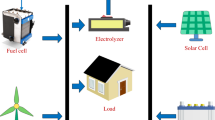Abstract
This paper presents the energy management tool of a power system operating in a smart grid that contains electric vehicles. The intention of this work is to make a comparison between a metaheuristic optimization technique and two fuzzy logic controllers, and with that highlight the advantages of using fuzzy logic and validate it to the detriment of other metaheuristic techniques. The optimization technique used was simulated annealing, in order to minimize the total energy cost of the system being studied. Tree charging strategies were adopted: peak charging, off-peak charging, and smart charging besides demand-side management techniques. In addition to the charging process will also be studied the battery electric vehicles discharging, preferably at the peak of the load curve, through the creation of a charging/discharging station. In this work, the system used is the IEEE-39 bus New England power system. Two fuzzy logic controllers have been developed, namely the charging station controller and the vehicle-to-grid controller. Together they decide the proper energy flow between the EVs and the grid. Energy discharge to the grid from EVs or energy required for charging EVs is controlled and tested for the real-time scenario. The results proved the effectiveness of the proposed method in studies of planning and expansion of electric energy systems that contain electric vehicles.



















Similar content being viewed by others
References
Al-OgailiI, A. S., Hashim, T. J. T., Rahmat, N. A., Ramasamy, A. K., Marsadek, M. B., Faisal, M., & Hannan, M. A. (2019). Review on Scheduling, clustering, and forecasting strategies for controlling electric vehicle charging: Challenges and recommendations. IEEE Acess, 7, 128353–128371.
Aghamohammadi, M., Parto, M., Ghods, A., & Ghazizadeh, S. (2012). Effects of V2G aggregators on the economic and loading performance of restructured power systems. In Cigré, 2012.
Braga, J. (2010). Integração de Veículos Elétricos no Sistema Elétrico Nacional. Dissertação. Departamento de Engenharia Eletrotécnico, Faculdade de Ciências e Tecnologia, Universidade Nova de Lisboa. Monte da Caparica, Portugal.
Dharmakeerthi, C. H., Mithulananthan, N., & Saha, T. K. (2014). Impact of electric vehicle fast charging on power system voltage stability. International Journal of Electrical Power and Energy Systems, 57, 241–249.
Energy Information and Administration Web Site. (2010). [Online]. Available in: https://www.eia.gov/electricity/monthly/epm_table_grapher.cfm?t=epmt_5_6_a.
Faia, R., Soares, J., Vale, Z., & Corchado, J. M. (2021). An optimization model for energy community costs minimization considering a local electricity market between prosumers and electric vehicles. Electronics, 10, 129.
Gao, Y., Guo, S., Ren, J., Zhao, Z., Ehsan, A., & Zheng, Y. (2018). An electric bus power consumption model and optimization of charging scheduling concerning multi-external factors. Energies, 11(8), 2060.
Garcia-Valle, R., & Vlachogiannis, J. (2009). Letter to the Editor: Electric vehicle demand model for load flow studies. Electric Power Components and Systems, 37, 577–582.
Hadley, S., & Tsvetkova, A. (2008). Potential impacts of plug-in hybrid electric vehicles on regional power generation. Oak Ridge National Laboratory, Oak Ridge, TN, ORNL/TM-2007/150.
Kipkpatrick, S., Gelatt, C. D., & Vecchi, M. P. (1983). Optimization by simulated annealing. Science, 220, 671–680.
Kongjeen, Y., & Bhumkittipich, K. (2016). Modeling of electric vehicle loads for power flow analysis based on PSAT. In 2016 13th international conference on electrical engineering/electronics, computer, telecommunications and information technology (ECTI-CON) (pp. 1–6). IEEE.
Lopez, K. L., Gagne, C., & Gardner, M. A. (2019). Demand-side management using deep learning for smart charging of electric vehicles. IEEE Transactions on Smart Grid, 10(3), 2683–2691.
Mithulananthan, N., & Saha, T. (2012). Impact of electric vehicle load on power system oscillatory stability. In Australasian Universities Power Engineering Conference, Hobart, TAS, Australia.
Milano, F. (2005). An open source power system analysis toolbox. IEEE Transactions on Power Systems, 20(3), 1199–1206.
Nissan Leaf Web Site. (2018). [Online]. Disponfvelem: https://www.nissanusa.com/ev/media/pdf/specs/FeaturesAndSpecs.pdf.
Pai, M. (1989). Energy function analysis for power system stability. London: Kluwer Academic Publishers.
Pang, C., Dutta, P., & Kezunovic, M. (2011). BEVs/PHEVs as dispersed energy storage for V2B uses in the smart grid. IEEE Transactions on Smart Grid, 3(1), 473–482.
SAE. (2010). Recommended practice for electric vehicle and plug in hybrid electric vehicle conductive charger coupler. SAE Standard J1772.
Sousa, T., Morais, H., & Vale, Z. (2012). Intelligent energy resource management considering vehicle-to-grid: A simulated annealing approach. IEEE Transactions on Smart Grid, 3, 535–542.
Sousa, T., Morais, H., & Vale, Z. (2016). Simulated annealing to handle energy and ancillary services joint management considering electric vehicles. Electric Power Systems Research, 136, 383–397.
Siebert, L., Aoki, A., Yamakawa, E., & Toledo, F. (2012). Gerenciamento pelo Lado da Demanda em Redes Inteligentes Utilizando Algoritmos Genéticos, IV SBSE–Simpósio Brasileiro de Sistemas Elétricos, 2012.
Singh, M., Kumar, P., & Kar, I. (2012). Implementation of vehicle to grid infrastructure using fuzzy logic controller. IEEE Transactions on Smart Grid, 3(1), 565–577.
Sullivan, J., Salmeen, I., & Simon, C. (2009). PHEV marketplace penetration: An agent based simulation. University of Michigan, Ann Arbor, Transportation Research Institute. UMTRI-2009-32.
Xiong, Y., Wang, B., Chu, C.-C., & Gadh, R. (2018). Vehicle grid integration for demand response with mixture user model and decentralized optimization. Applied Energy, 231, 481–493.
Wang, L. (1997). A course in fuzzy systems and control. Prentice-Hall.
Wu, T., Yang, Q., Bao, Z., & Yan, W. (2013). Coordinated energy dispatching in microgrid with wind power generation and plug-in electric vehicles. IEEE Transactions on Smart Grid, 4(3), 1453–1463.
Acknowledgements
This present work is funded by the Coordenação de Aperfeiçoamento de Pessoal de Nível Superior–Brasil (CAPES). Cód. de Financiamento 001.
Author information
Authors and Affiliations
Contributions
M.A.A.V. contributed to Conceptualization, methodology, formal analysis and investigation, writing—original draft preparation. C.T.dC.Jr. was involved in writing—review and editing, acquisition, resources, supervision.
Corresponding author
Ethics declarations
Conflict of interest
All authors declare that they have no conflict of interest.
Additional information
Publisher's Note
Springer Nature remains neutral with regard to jurisdictional claims in published maps and institutional affiliations.
Rights and permissions
About this article
Cite this article
Viegas, M.A.A., da Costa, C.T. Fuzzy Logic Controllers for Charging/Discharging Management of Battery Electric Vehicles in a Smart Grid. J Control Autom Electr Syst 32, 1214–1227 (2021). https://doi.org/10.1007/s40313-021-00741-w
Received:
Revised:
Accepted:
Published:
Issue Date:
DOI: https://doi.org/10.1007/s40313-021-00741-w




